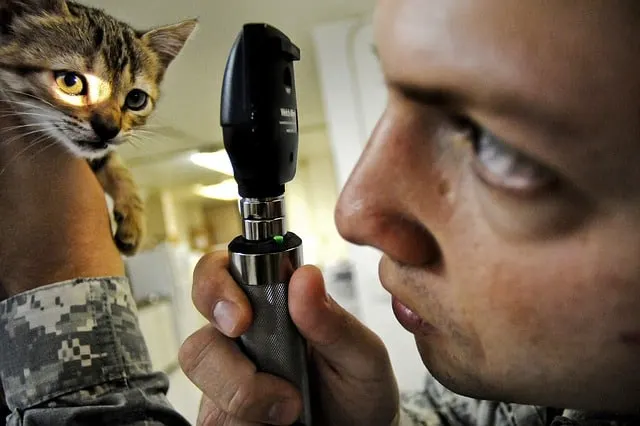Cats and rabies are two concepts that, in my mind, are less commonly associated together than say, a wild raccoon and rabies-for example. But what’s important to know as cat owners is that your cat, if not properly vaccinated or bitten by an infected animal, can contract the otherwise preventable viral disease.
In this article we will discuss cats and rabies and what you need to know in order to protect your cat (and other pets) from becoming infected.
What is rabies, anyway?
Rabies is a viral disease that causes inflammation of the brain. It can infect mammals, wild and domesticated, and this can also spread to humans. The spread of rabies is due to the transmission of the virus via bites, scratches, and by coming in contact with virus particles transferred by the salivary glands. Though we won’t enter into details about the scientific cause of rabies, we will discuss more in depth the transmission, symptoms, and diagnosis of rabies as well as prevention and treatment.

How rabies spreads
It is important to know how rabies can be transmitted to your kitty cat. This is especially important if you have an outdoor cat.
Check for animal bites, scratches, or other wounds (scabs, abscesses, etc.) If your cat comes back inside with a few “battle scars” it is important to take a close examination of the wounded area. If the wound (bite or scratch mark) has teeth marks, is swollen, red, or looks infected – take your cat to see the veterinarian as soon as possible. Don’t wait!
Take caution: If you have other pets (dogs, more cats) in the house, then it would be best to separate them and their food and water bowls. If your cat comes back inside, and has indeed been bitten by an animal suspected to be infected with rabies, and shares the water bowl with the other kitties then they will also be at high-risk of contracting the virus.
Outdoor cats have a higher exposure to wild animals or neighborhood cats (that may not be vaccinated) and this increases their risk of contracting rabies. It is ideal to keep your cat indoors, especially overnight. If you have a mostly outdoor cat, it is vital to keep a close watch and to always check him/her for scratches or bites when they come back inside.
All cats – indoor and outdoor – should be vaccinated against rabies! It is a fatal disease to both our pets and us, so not only is it beyond wise to have your indoor/outdoor cats vaccinated, it is also required by law in many states.

Early warning signs of rabies
If you suspect your cat has been bitten, etc., then there will be some early signs you can look for. If there are any of these signs, quickly take your cat to the local veterinarian. When in doubt, go just in case because the decision could be a fatal one.
Early signs (non-specific) of rabies can vary between two and ten days.
Early signs include:
- general feeling of sickness
- muscle pain
- disinterest in food, malaise
- vomiting and/or diarrhea
- fever, chills
- restlessness, discomfort
- fear of water
These warning signs are actually very similar to the signs/symptoms found in humans infected with rabies.
Symptoms of rabies
There are two types of rabies: paralytic (sometimes referred to as “dumb”) rabies and furious rabies. When we think of rabies, we often think of the furious type, though actually it is the paralytic form of rabies that is most commonly found in cats.
Paralytic rabies in cats will show signs of confusion, lethargy, or sickness.
This type of rabies does not make your cat aggressive like the furious type of rabies. Your cat will not be likely to bite you, but it is always important to be very cautious.
Symptoms of the paralytic form of rabies will include:
- paralysis, inability to move
- difficulty swallowing
- foaming of the mouth, excess salivation
If there is a cat or other animal in your neighborhood displaying this behavior, we recommend to take the cat immediately to the veterinarian or call your local animal control to assist you. In the meantime, keep your pets inside.
Furious rabies in cats is less common, but it is what we typically think of when we think of rabies. This form of rabies will result in abnormal behavior, aggression, and foaming of the mouth.
Symptoms of this kind of rabies include:
- aggressive, attacking behavior
- excess salivation
- abnormal behavior
- fear to go near water/sound of water
Never hesitate to contact animal control to assist you with a rabid cat. This way you ensure the cat does not bite you when you try to help it. Keep you and your pets at a safe distance/indoors and warn your neighbors of the rabid cat just in case.

Diagnosis of rabies in cats
According to WebMD,
“There is no accurate test to diagnose rabies in live animals. The direct fluorescent antibody test is the most accurate test for diagnosis, but it can only be performed after the death of the animal. The rabies virus can incubate in a cat’s body anywhere from just one week to more than a year before becoming active. When the virus does become active, symptoms appear quickly.”
Rabies therefore is not a matter to be taken lightly.
In most cases of clear rabies, vets will suggest euthanasia. If the owner refuses euthanasia, the cat could be quarantined at the owners cost for at least six months at the veterinary clinic.
Treatment
There is unfortunately no known treatment or cure for rabies.
Prevention
Vaccination!
Because there is no treatment for rabies, it is absolutely essential that you vaccinate your pets regularly! Vaccination is the best preventive method to contracting the viral disease. When adopting a cat from a shelter, they will require your new kitty to receive a vaccination against rabies or a vaccination booster. If you find a stray, or adopt a cat from the street, take them immediately to get a vaccination and to receive a health check-up.
Other preventative measures include:
- Choosing your family pet wisely
- Keeping cats indoors
- Not approaching wild animals or
- Not handling unknown cats
- Exercising caution near domestic or neighborhood cats
- Observing/examining your cat regularly
- and…. keeping your pets vaccinations updated! 🙂
Final thoughts: Cats and Rabies
Please keep your kitties safe and have them vaccinated! We hope no family or animal suffers from this fatal disease. Please feel free to share your personal experiences or stories with the Fluffy Kitty community by posting your comment below or by contacting us by email or joining us on Instagram, Facebook, and Twitter. Share this article with your furiends!
<3 from our furry family,
Brittany, Paul, and Yoda =^^=
